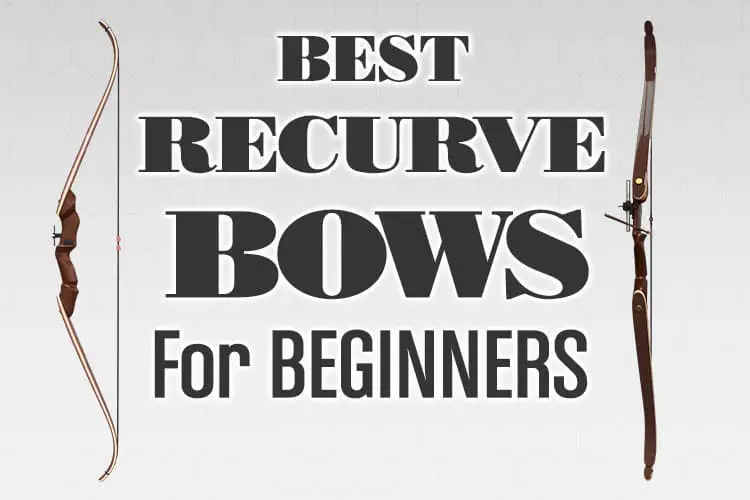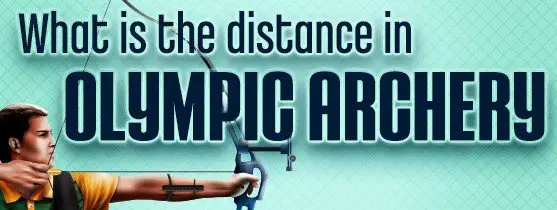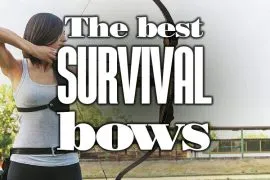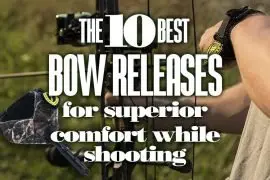However, we have already taken the time and researched different beginner bow available in the market so you don’t have to. You can use the extra time to hone your archery skills. Our focus in the search was on features preferred by beginners such as accuracy, durability, and comfort. We will also be looking at the price of each bow.
Features to look for in a Recurve
Table of Contents
Here are the features you should be looking for when shopping for the best recurve bows for beginners:
Draw Weight
Draw weight simply means the amount of force an archer needs to apply to the string in order to fully draw it back and efficiently shoot an arrow. If a bow has a high draw weight, it means it transfers more energy to the arrow leading to straighter and more powerful shots. But bows with a high draw weight are not necessarily the best recurve bows for beginners.
The reason for this is that the bow’s draw weight can only enhance your archery if you have the right physique to handle it. For example, you may find it hard to steadily hold the drawstring when lining up your shot and your arms may shake from the strain. Your ideal bow draw weight depends on your build, sex, and general strength.
A draw weight that is too high may overpower you and negatively impact your technique. As a beginner, you should start with a draw weight that you can easily pull without using too much effort. As you continue using it you will develop good muscle memory and strength.
Eventually, you will be able to use a bow with a more powerful draw weight. Generally, the draw weight for hunters is 40 pounds. Any bow with a draw weight of fewer than 40 pounds will limit you in the distance your arrow can travel and the arrow may not pierce the target as well as it should.
Generally, most males age 16 and above can handle a 40lb recurve bow, but petite females and other teenagers may have a harder time. But who knows, you may just be able to handle a 40lb recurve bow as a beginner. All you have to do is try one out before you make a purchase.
The point is that as long as you decent back and arm strength you can use a recurve bow. People just starting archery should stick with easy recurve bows which have a lower draw weight.
Bow Weight
Just like a sword or rifle, the bow weight affects the performance of the person using it. By bow weight, we mean the weight of the physical bow itself. As you position yourself to shoot an arrow, you may have to hold the bow for an extended period of time. A heavy bow may make it hard for you to position yourself correctly as you try to shoot or may make you tire easily.
Easy recurve bows that weigh below 3 pounds are great for beginners. In fact, most bows weigh between 2 to 3.5 pounds.
Riser
The place where you grip the bow as you position it to shoot is called the riser. Recurve bows can have either a wood riser or a metal riser. A wood riser is cheaper and tends to look better aesthetically compared to a metal riser. Metal risers tend to have special grips to allow you to hold them even when it is hot or cold.
These special grips can also act as a cover for the bare metal riser and are often made of rubber or wood. But bare wood risers do not need special grips. A riser can sometimes come pre-drilled for a variety of accessories such as an arrow rest, stabilizer and sight. You can DIY drill a wood riser that does not come pre-drilled but doing that may void your warranty.
Other accessories like the arrow rest can be glued on to a bow that does not come pre-drilled. Beginners do not need all these accessories or fitments because you get an accessory depending on what you want to do with the bow. For example, an accessory needed by a hunter may not be that important or necessary for a target archer.
The best recurve bows do not have to have all the accessories installed unless you want to look like a Marvel Superhero.
Length of the Recurve
A recurve bow should be two times longer than your draw length. To measure your draw length, try to spread your arms parallel to the floor without pulling your shoulder blades together. Then have someone measure the arm-span from one middle finger to the next with a measuring tape.
Divide the value y 2.5 and what you get is your approximate draw length. Now multiply that value by 2 and you will get your ideal to recurve length. Generally the longer the bow, the more accurate it is.
Are you Left or Right Handed?
Some bows are designed for both right-handed and left-handed people. However, these types of bows may restrict your draw weights on one hand or the other. Just choose the right-handed bows if you are a beginner.
Quality of the String
Strings wear out over time and so a bow with a durable string may save you money which you may have been able to use on replacements or upgrades. Most beginner bows come with a string that is of acceptable quality.
Take Down Recurve
Ever watched a spy movie where a sniper skillfully disassembles his sniper rifle and stores it in a suitcase. You can do the same thing with a “Take-Down” bow because it allows you to separate the two limbs from the riser. Once you remove the limbs you can store them with the riser in a handbag or backpack.
But apart from easy storage for transportation, removable limbs means that you can easily service your bow. All you need to do is remove the specific part that needs fixing and sends it for servicing instead of sending the whole bow.
Take-down recurve bows are great for beginners because they allow you to adjust their draw weight. The draw weight relies on the stiffness and the construction of the limbs. To upgrade the draw weight, all you need is to purchase a new set of limbs with your preferred draw weight.
Some Take-down bows require tools to disassemble while others require no tools.
Price of the recurve
Price is not a feature, but it is the first thing you have to consider before choosing the best recurve for you. So before you spend a fortune buying a recurve, you will need to consider the affordability and durability of the bow. You will need to think about how frequently you will be using the bow and how that will impact its durability.
The more you use it and the manner you use it will determine how many times you will have to buy replacements. You will also have to consider any possible upgrades your bow may need in the future. Try not to misuse your bow and only allow an experienced stringer to string it for you. Misuse could lead to you voiding your warranty.
Best Recurve Bows for Beginners
Now that we have looked at the features you should consider while shopping for a recurve, below are some of the most popular recurve bows we found:
Samick Sage Bow
Sage is one of the few bows that you can use from the beginner level to the advanced level without having to replace it. You can change the limbs of the Sage and it comes in a wide range of draw weights making it appropriate for beginners. You can have this excellent performance and good looking recurve for $150.
Pros
The removable limbs make it easy to store or pack the bow in a backpack if you are traveling. Additionally, you can change the limbs to adjust the draw weight of the bow to suit your archery level. Not only are the limbs cheap but they are also very easy to replace because of their bolt design.
Sage has pre-set bushings that allow you to install a quiver or sight. It also comes with a right or left-handed configuration and the draw weights range from 30 to 60 pounds. Its riser has a two-tone glossy shiny surface, which gives it a unique look. It is quite affordable.
Cons
There have been cases where buyers have new bows with unfinished wood pieces that sometimes break easily. Experienced archers may also need to upgrade the string on the bow and a string silencer is recommended for hunters. But these issues are not widespread.
Southwest Archery Spyder Bow
The Spyder is lighter and has a better build compared to the Sage. The bow is elegant, has a redwood finish riser, reinforced limb tips, rounded edges and more. It has a variety of draw weights and comes with two different Archery Manufacturers Organization (AMO) lengths – regular and XL. The regular or normal has a length of 62” while the XL has a length of 64”. It also has removable limbs which can be interchanged with those of the Samick Sage.
Check out this video for complete review.
Pros
You can pick between the 62” or the 64” AMO length depending on your archery level. Its wide range of draw weights means that you can use it as a beginner or advanced archer. Apart from it being a Take-down recurve, it’s also light in weight and you can interchange its limbs with those of other excellent recurves like the Samick Sage or Samick Journey.
Cons
It being a Take-down recurve is great, but you still need tools to assemble or take it down. These tools can easily be misplaced or forgotten. Overall, the Spyder is still a worthy recurve.
Martin Jaguar Recurve Bow
The Martin Jaguar has a modern-looking aluminum riser and is very comfortable to hold. It has a Take-down design which makes it versatile and also enhances its shock absorption. If you are a beginner, it will help familiarize you with the act of shooting a bow. It is also great for intermediate archers. You can use it both for target practice and hunting depending on the draw weight.
Check out this video for complete review.
Pros
The aluminum riser makes the bow durable but lightweight. It also gives it an extremely solid feel that makes you feel like you are holding a sophisticated rifle. Its Martin’s Thermal V Grip makes the bow easy to grip in any weather conditions and also decreases vibration noise.
You can break it down easily for packing into a backpack or for storage. Its take-down design also allows switching the draw weights. This 40lb draw weight recurve has laminated wood and glass limbs that offer a smooth draw.
If you find stringing a bow challenging like the rest of us, you will appreciate the stringing tool that comes with the bow. But you can always find an experienced stringer to string a bow for you. Hunters love its camouflage design because it makes the bow blend perfectly in the woods.
Cons
Compared to the Sage, the Jaguar has few weight options, which is bad news for people who are beginners. But for people with greater upper body strength, this bow is just what the doctor ordered. Of course, beginners can use it, but only people with a greater amount of upper body strength can utilize it effectively.
Another con is that the arrow rests made for this bow by its manufacturer are not the best.
SAS Courage Bow
The SAS is a traditional takedown bare bow that comes in a range of draw weights and has a hardwood riser. This sturdy recurve has a sleek design and its latest model comes pre-drilled for various accessories like a stabilizer, arrow rest and sight.
Pros
Unlike many other recurves, the SAS is often supplied with an arrow rest. It also comes in left and right-hand models and has a 3-year limited manufacturer warranty.
Cons
You may find it hard to upgrade its string because the limb tips are not reinforced for upgrades. If you are a beginner, this bow’s 60” AMO length may not be ideal. A longer bow offers much more accuracy.
Recurve Bows Guide for Beginners Conclusion
The bows we have discussed here are some of the best recurves out there. My personal favorite is the Southwest Archery Spyder Bow.
As you try out different recurve bows in the store, consider:
- Type of riser (wood or metal)
- Price
- Bow length
- Bow weight
- Ability to upgrade
- Warranty
Frequently Asked Questions(FAQs)
Are recurve bows good for beginners?
Recurve bows are simple to use and maintain, as they can be customized to fit any archer’s needs. Recurves are more accessible for novices since they aren’t only affordable (unlike most compound bows) but also come in a wide range of draw weights that may be upgraded as the archer grows.
What recurve draw weight should I start with?
Choose a recurve bow with a draw weight of 40 pounds or less. You can now hunt for a small game like turkey and rabbit with a 35 or even 30 lbs. bow, but anything bigger than that (deer, elk) will necessitate 40 lbs. or more draw weight so while you might be able to handle only 30 lbs.
Which bow is best for beginners?
A recurve bow is the best type of bow for a beginner. With the most adaptable and cost-effective form of bow available, you may learn the fundamentals of archery before investing in a more expensive compound.













25 Comments
I brought Samick Sage Bow for my archery practice. The design of this bow is quite excellent and really brings mobility to archery. The 60lb draw was a bit tough on day one, but once I got some gloves on my fingers I am staying inside a 10″ target with some old arrows and home-brewed fletchings. To anyone purchasing this bow, I would really recommend using grip tape on the handheld and replacing the plastic arrow hold for the shelf with leather shelving.
Pingback: Barebow - Boss Targets Archery Bows
I am very pleased with this Southwest Archery Spyder Bow. It is my first bow and I think it’s beautiful and easy to use. I was disappointed when I realized this bow does NOT come with a set of arrows as is described in the listing title.
It is my first bow and I think it’s beautiful and easy to use The 60lb draw was a bit tough on day one, but once I got some gloves on my fingers I am staying inside a 10″ target with some old arrows and home-brewed fletching’s.
Pingback: Archery Equipment: A Basic Guide - Boss Targets
Pingback: Best Bow Cases For Protection Of Bow - Boss Targets
Pingback: Bowstring Finger Position - Boss Targets Archery Advice
Pingback: Best Recurve Bow Cases - Boss Targets
Pingback: Best Archery Arm Guards - Boss Targets Archery Arrows & Equipment
Pingback: Best Longbow For Archers - Boss Targets
Pingback: Best Recurve Bows for Beginners, for Advanced Archers, and for Hunting
Pingback: Archery Mistakes Common for Beginners - Boss Targets
Pingback: The Ultimate Guide to Bow Quivers - Boss Targets
Hi, I am John Robert Your article “Best Recurve Bows For Beginners 2021(Reviews + Buying Guide)” is very helpful for me. After reading your article I got a lot of knowledge from your article. I have some knowledge about bow but after reading your article I think; I have to gain more knowledge about this topic. Thanks!
Pingback: Discover the Many Types of Bows - Boss Targets
Pingback: 25 Reasons why Archery is Good For Kids - Boss Targets
Pingback: How to travel with Archery Equipment - Boss Targets
Pingback: Adoption of the Bow and Arrow in Northern America - Boss Targets
Pingback: How to Nock an Arrow - Boss Targets
Pingback: What is the Ideal Draw Weight for My Bow?
Pingback: Best Beginners Bow & Archery Style? - Boss Targets
Pingback: Compound or Recurve Bow – Which one is Best and Why?
Pingback: How to Determine Your Perfect Recurve Bow Size quickly
Pingback: Useful Crossbows fundamentals for Hunters and Target Shooters
Pingback: How to Shoot With Proper Archery Form - Boss Targets